3 Chapter 3: Sales Engagement Process – Pipeline (Funnel)
The Sales Pipeline (or funnel as it is commonly named) is the organization’s roadmap that tracks a client from “Prospect” to “Implement”. It can be the indicator or life or death of the organization.
The process includes positioning a prospective client into the “pipeline” so that the sales team and leadership can maintain a sales focus through sales engagements to the point where the business is “won” or “closed lost” (meaning – we decided to not continue the pursuit of the business, or we did not have a convincing value proposition and a competitor won).
Pipeline stages may look slightly different depending on the industry or firm. The differences will largely be due to internal metrics of the sales leadership team. However, overall, the process and fundamentals of the pipeline is the same regardless of the organization.
For the study of this most important aspect of sales and sales management, the text will use a pipeline with commonly recognized stages. Much study will be given to the understanding of each Phase of the Pipeline as well as the metrics for managing the business of sales. It is a primary goal for students to be as skilled as a sales manager regarding the sales process and metrics that make up the pipeline and forecasting.
Pipeline (Funnel)
The sales pipeline is called pipeline because of its resemblance to a pipeline or funnel filled with fluid and as fluid moves through the pipeline, it is released at the end point (realized as producing revenue). The Pipeline can be referred to as targeted companies or as the revenue opportunity that we are pursuing.
Sales managers refer to the pipeline containing companies (opportunities) and revenue. For example, Sketobe Enterprises may be a firm that we are trying to win. The annual revenue for Sketobe is $1.2 million. A sales manager may ask, “How are the talks going with Sketobe?” The sales professional would respond, “Currently Sketobe is in the Explore Phase of the pipeline for $1.2 million. Our meeting on Thursday went very well. We have a follow up on Monday to discuss the warehouse management process.”
Notice how the Pipeline guided the discussion for the management team. The message was concise and clear. The manager has a good idea of the situation (at a high level). If more needs to be discussed about the strategy, the manager would have a follow-up question (we will study strategy later in the text).
The process of the Pipeline will be professionally performed using a Customer Resource Management (CRM) system. One may commonly recognize firms like Salesforce.com for this tool.
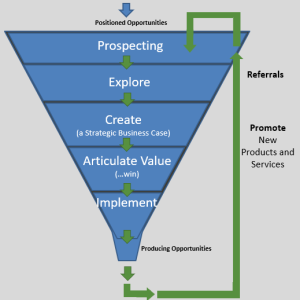
Phases of the Sales Process
The Sales Process is broken down into distinct phases. These phases do not necessarily correlate to the Sales Visit flow. However, these may run in tandem depending on the timeline of the actions of the sales team and the client.
Where to start, this is where you need to slow down to speed up. Meaning, if the sales professional doesn’t get this right, they will spend all their precious time on clients that may not produce. Successful sales professionals understand that there is a long- and short-term strategy related to the Pipeline. There is a “Hit Rate” (discussed later in the text) that we need to understand. There are profitability elements to consider. There are cost elements to consider. For example, would we travel to a client and spend two days when we could have stayed in the city and visited with three opportunities? The answers are always…it depends. We must give research and thought to the “it depends” factors. A sales professional’s time and territory management are as important as the clients in the pipeline. Without prioritization skill related to the territory and time, the sales professional can find themselves practicing bad habits.
The act of Prospecting can be an arduous task. Many firms hire niche players to pre-qualify opportunities so that they focus their valuable time on real, viable opportunities. Viable means that the opportunity that we are positioning for the Pipeline has everything that we are looking for in a client. The client has the potential to buy at the level that we need and the KDMs are open to discussing a potential agreement.
Homeruns are great. But base hits win games. This metaphor speaks to the anxious sales professional that spends too much time with the large complex sale while leaving out the client base that can facilitate strong company growth. The large fish are more longer-term targets. They are very important and must be pursued with vigor. However, the medium to small fish still fries up quite nicely to put food on the table for the organization. The moral of the story is to maintain a balance of long- and short-term targets.
Positioning the right client into the Pipeline should meet the criteria of the following:
- Viability – the opportunity is real and verified to be interested (and not contractually bound to another).
- Decision – has the capability to make or heavily influence a decision to make a deal.
- Profitability – the firm meets your operational cost structure to serve.
Sales success takes Cadence. Meaning, we must maintain a continuous flow of new opportunities through the Pipeline to support the organization. There should be a balance to the number of opportunities within the Pipeline Phases. Pipeline Balance allows us to forecast new revenue to the team in a succinct manner. For example, based on current market conditions and our historical hit rate, we forecast $1.2 million new business to produce in March, $500,000 in June, and $1.4 million in August.
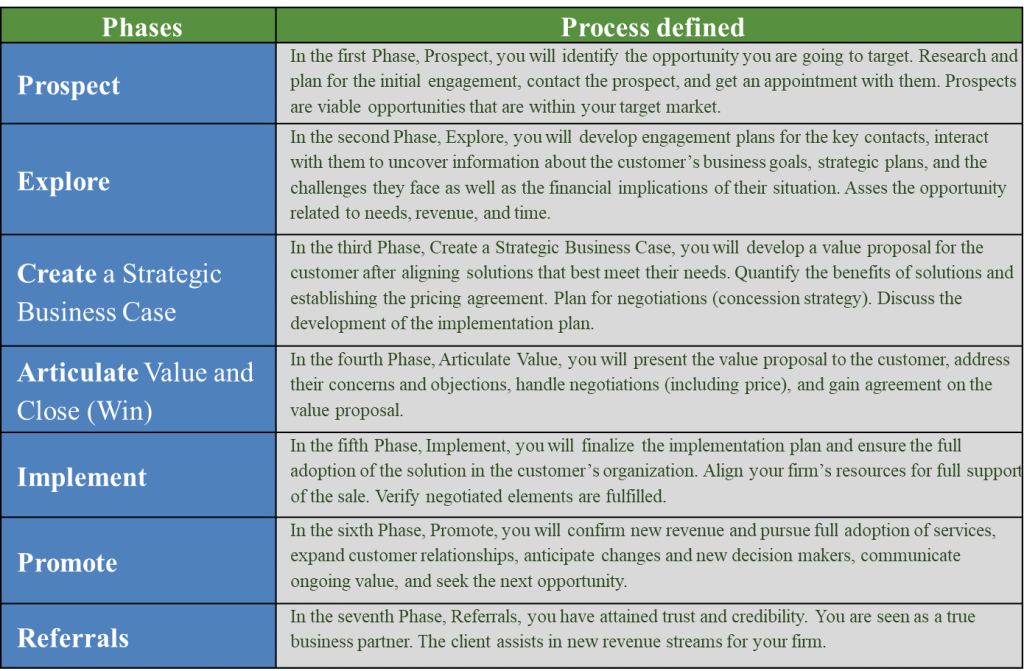
Role Play
This role play is provided to help you learn how to properly introduce yourself to a client. Students will perform an individual exercise of personal introduction.
Prepare for your message. Then video your introduction. Upload to your facilitator. You will receive personal feedback based on the interaction of the recording. Work hard to make it as real as you can. Use your best judgement.
RULES:
- Prepare – 10 minutes
- Introduction should take approximately 3 minutes (video the process – check your audio and video settings prior to the role play.)
- Upload Video per facilitator instructions
Scenario notes: You are a student working for the University of North Alabama. You are selling a sponsorship discount program called Mane Benefits. Act as if you have a business card stating the purpose of your visit. The client is expecting you (you have a firm appointment). Act natural.
Phase 1 Prospect
In the first Phase, Prospect, sales professionals will identify the opportunity they are going to target. Research and plan for the initial engagement, contact the prospect, and get an appointment with them. Prospects are viable opportunities that are within the target market.
- Prioritize targets.
- Research and plan for initial contact.
- Prepare sales message/marketing theme.
- Contact prospects to obtain meeting.
- Secure specific date, time, and agenda.
The first meeting in the sales process is usually mostly informative related to contacts, responsibilities, and business output (what the firm does at this location). First impressions are always important. As with any personal engagement, keeping it light related to the job may be a plus. The objective of the prospecting meeting is to get a “lay of the land” and determine what the next steps should be to explore the firm as a real candidate for doing business.
Being prepared with marketing information about the sales team’s firm is one of the critical pieces of this phase. Professionalism and personality will go a long way to ensure you get a contact for the next meeting.
For most sales professionals, contacting the CEO for the first visit is not a good strategy. If the business is medium sized to small, the CEO may be the right place to start so that the sales team can gain permission to have business conversations with the influencers.
Prospect meeting opening statements and questions may be as follows:
- Sales Professional (SP) – “Thank you for the video meeting, I understand that you have 10 minutes. Is that right?”
- VP – “Yes, I have another meeting at 10:00. What can I do for you?”
- SP – “I am responsible for client relations within the southeastern United States for BM Petroleum, the nation’s largest supplier of manufacturing lubricants. I would like an opportunity to get to know you and your staff to determine if my firm and I can cultivate a partnership here at CBA corporation.”
- VP – “Well, we appreciate your inquiry. However, we already have a relationship with a provider.”
- SP – “I understand. We are the nation’s leader because we focus on customer service and the highest quality products. Our sales teams are skilled in manufacturing. I am an industrial engineer by education. I know that your business is very successful. However, it is rare when I can’t find some way to assist a company like yours. I would like an opportunity to meet with several of your team members including the operations manager and maybe your team leader. If I find some challenges that we could resolve for your firm, I would like to get approval to present a proposal to you and your staff regarding our capabilities and a future partnership. If I don’t identify any areas, that will simply add confidence to your team’s performance.”
- VP – “I will set up an introduction to meet our operations manager for the manufacturing division. Keep me informed as to any progress. I am interested regarding whether you find anything to improve.”
- SP – “Thank you. How does Tuesday, the 27th at 2:00 pm look on your calendar?”
- VP – “That works.”
- SP – “Great, I will send an invite as well as an agenda. Please add anything that is of importance to your team to the agenda. I appreciate the time and look forward to our next meeting.”
Phase 2 Explore
In the second Phase, Explore, sales professionals will develop engagement plans for the key contacts, interact with them to uncover information about the customer’s business goals, strategic plans, and the challenges they face. Assess the opportunity related to needs, revenue, and time.
- Identify key decision makers/influencers
- Seek strategic and tactical knowledge (who does what, when, and how?)
- Uncover challenges and develop needs (why?)
- Determine cost implications (how much?)
- Use marketing Insights to position your product/service with an advantage over your competitor
- Assess and size opportunities
Identifying Key Decision Makers and Influencers
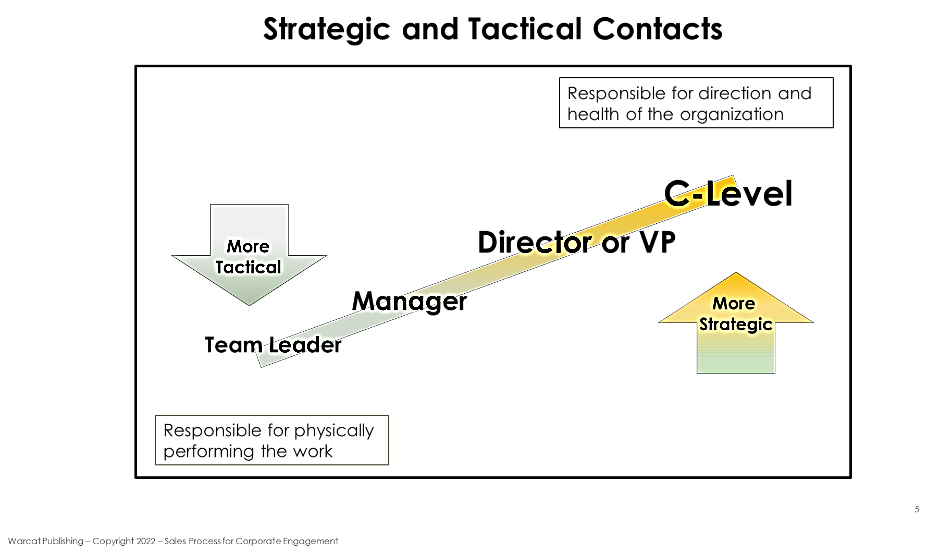
In this phase, sales professionals will develop a call plan and identify key players and decision makers in the customer’s organization. Successful sales professionals qualify the contacts position early in the sales process. Each person in the organization is important. Sales professionals must concentrate time on the KDMs and KDIs.
Influencers can reach from Team Leaders all the way to the C-Level. Skilled sales professionals ask questions to determine the nature of the contact’s responsibility related to the sales professional’s industry or product. Questions related to determining the range of tactical or strategic influence may be as follows:
- “Who should be involved in the process of discussing the challenges with…?”
- “Who is involved in the decisions to make a change related to…?”
- “If we were to begin serious discussions, is there anyone else that we will need to be informed?”
Develop a Call Plan
Developing a call plan begins with understanding the position of the contact within the organizational structure as it relates to influence and decision-making. Once the sales professional has identified the contact for the meeting, the development of questions is critical to success.
Every phase should begin with research. Researching the contact is basic-level importance. Social media platforms like LinkedIn are a good place to start to learn more about your contact. The client contact’s history can provide a wealth of knowledge for preparation, especially as it relates to building rapport. Proper building of rapport in the first five minutes of the meeting can make or break the entire sales process. Preparedness is key.
Seek strategic and tactical knowledge (who does what, when, and how?)
Once rapport is prepared, build questions that are appropriate to the position of the contact. Questions for the C-Level will be more strategic in nature than the Team Leader. Team Leaders’ responsibilities are more tactical in nature. The Team Leader may not know the projected three-years sales for the organization. But he or she may know how your product or service will specifically affect the operation line. Both sales and operational impacts are very important to the sales process. Knowing how to position the questions and whom to ask is part of the process that brings success.
Getting meetings with contacts of both tactical and strategic within the organization will allow the sales team to build a better value proposal. Examples of strategic and tactical questions are as follows:
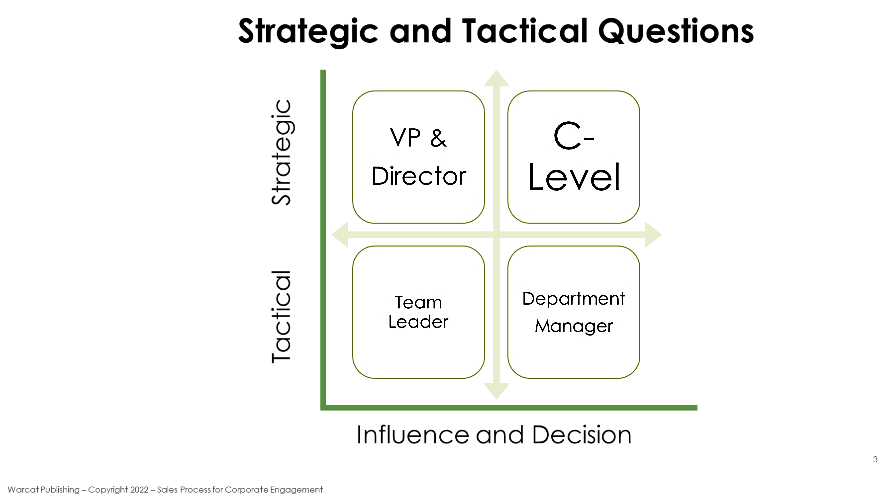
Strategic
- C-Level – “How is the looming recession affecting your decisions for future acquisitions?”
- VP & Director – “How will the change in cost of capital due to interest rate hikes affect your hiring plans in the short term?”
Tactical
- Department Manager – “What elements on your Key Performance Indicators (KPI) or Balance Score Card (BSC) are receiving the most pressure at this time?”
- Team Leader – “How is the current shortage in lubricants affecting your assembly line processes?”
Each of these questions is important. However, they are very different in nature. The sales team must have these questions prepared in advance of the sales visit and ensure that the nature of the question is appropriate to the audience.
Tactical questions get answers related to processes that will be used to build the business case for the sales teams’ product or service.
Strategic questions uncover the direction of the firm and the vision of the leadership. Often, this point is overlooked. Leaders are looking for strategic partners. The sales planner must contain questions that are bother strategic and tactical.
Uncover challenges and develop needs (why?)
Within the context of the Sales Process (may be different than the Sales Visit), the sales professional is developing the needs of individuals and the organization. While the individual Sales Visit is focused on the person that you are currently meeting, the Sales Process will be a culmination of the multiple people and visits to put the challenges and cost implications together in a business case so that the entire picture can be determined.
The sales team business case may have information as follows:
CBA Corporation Primary Challenges
| Contact | Challenge 1 | Challenge 2 |
| COO | Supply Chain – China | Inventory On Hand |
| VP Operations | Inventory On Hand | Manufacturing Defects |
| Operations Manager | Manufacturing Defects | Lubricant Availability |
| Team Leader | Lubricant Availability | Employee Training |
The challenges may build upon each other as in the chart above. The sales professional is responsible for listing the challenges in priority of importance to the client. Part of the prioritization process is determining the cost implications of the challenges.
Determine cost implications (How much?)
A “Defining Value” cost worksheet example is provided below:
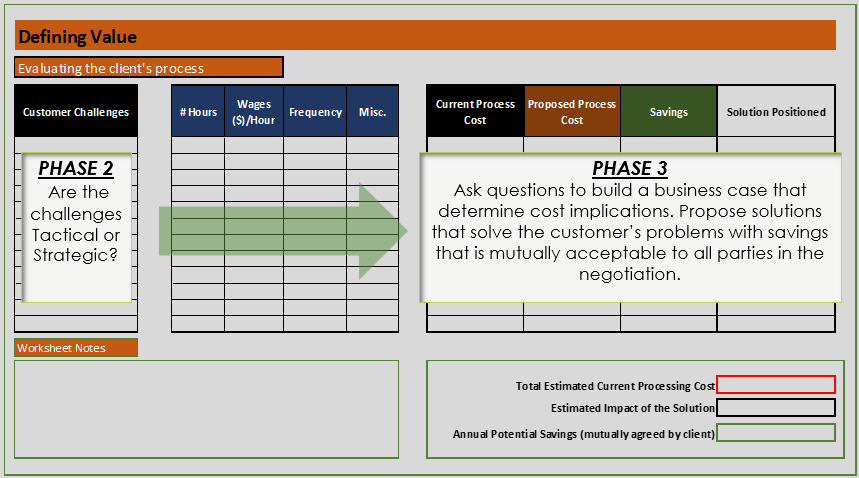
During phase 2 and 3 of the sales process, you will quantify and qualify the opportunity. As you work to fill out information that moves you into the next phase.
Phase 3 Create a Strategic Business Case
In the third Phase, Create a Strategic Business Case, sales professionals will develop a value proposal for the customer after aligning solutions that best meet their needs. Quantify the benefits of solutions and establish the pricing agreement. Plan for negotiations (concession strategy). Discuss the development of the implementation plan.
- Align company solutions and resources.
- Quantify value in customer terms.
- Develop strategy and key objectives.
- Create value proposal.
- Discuss implementation plan development.
- Anticipate dangers of the situation.
- Prepare a negotiation planner.
Current Process and Proposed Process should always be part of the business case. Many firms use Industrial Engineering to model the process. Industrial Engineers can provide time-studies of processes to determine the true cost. For example, if a production line has six employees and there is a process within their assigned duties that causes a pause or rework by an employee, the time for the process, including the rework, must be accounted for to determine the true marginal cost of a product or service.
Time-study example:
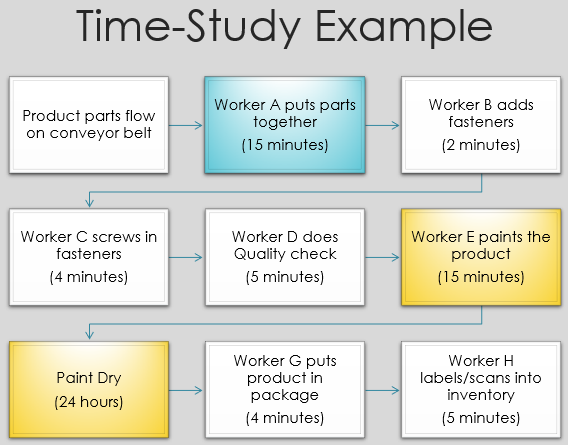
The sales team may identify three areas that could be a focus of concern. Worker A, E, and the Paint Dry steps in production of the product is where we can position ourselves. After discussing processes with the client, we may conclude that Worker A is outside of our expertise. However, the painting of the product is where we can have a significant impact on the client’s operation. The client is having production “down time” due to the paint taking more than the planned time to cure.
The client is using a high-quality paint line that is known for its durability. But the time to dry during production can be improved if the customer were to consider our solution. We sell a paint additive that increases the drying time by 50%. In addition, we can install “no-noise” drying machines on the line that will cut the overall dry time to only four hours – an 83% improvement to the paint-drying process.
As you are positioning the solutions, add the paint additive and the drying machines to your defining value worksheet; ultimately to your formal presentation that will be presented in Phase 4. During the next phase, will articulate the value of the 83% savings in dry time. There must be a monetary value put on the cost of the 24 hours of dry time. How would an 83% dry time help the operation? What if you can eliminate the downtime related to drying? Use the overall savings to position your product and sell the customer.
Phase 4 Articulate Value and Close
In the fourth Phase, Articulate Value and Close, you will present the value proposal to the customer, address their concerns and objections, handle negotiations (including price), and gain agreement on the value proposal.
Current State / Future State
We will present the Current State and the Future State. In the case of the production line, it may look like the following:
Current State
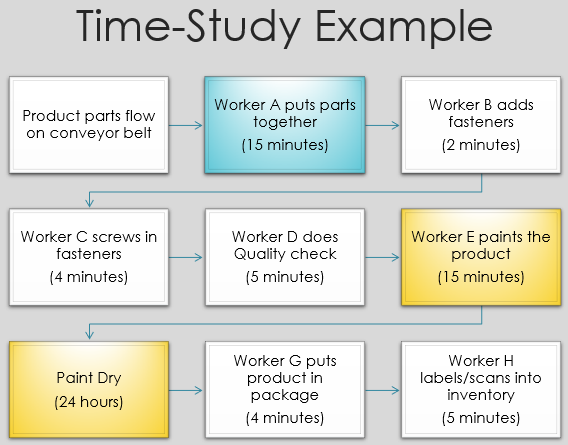
Future State
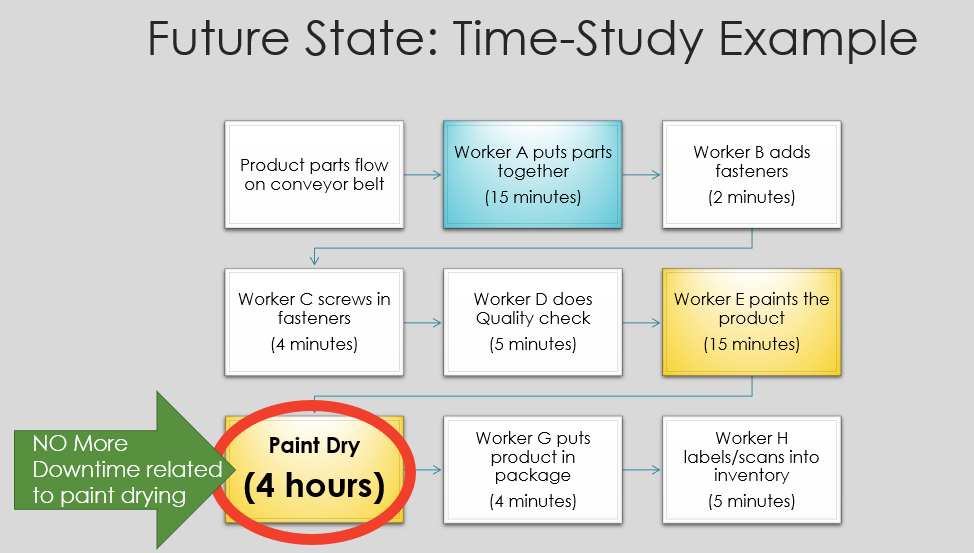
Marketing Insights
Marketing insights are bits of real research that substantiates your claim and helps position your product or service higher in the mind of the customer. The following are a couple of examples:
- “Scientist from leading universities demonstrate in laboratory research and confirmed with fortune 50 companies that our Prime-Time paint drying machines cut drying time by 83% on average compared to other manufacturing processes.”
- “9 out of 10 production managers chose the Prime-Time paint drying unit over the next leading paint drying process.”
Articulating the value is the foundation for the sales process. Position power in the negotiation by showing your understanding of the current process and demonstrating your solution that overcomes the challenge.
Using the marketing insights, on-site testing with the client, and cases from other third parties will allow the sales team to Propose to Move Forward. It is at this point that the sales team may encounter an objection.
Defining Value
Defining value only comes through effective questioning and meeting with the right influencers. Once the sales team has investigated the situation and determined appropriate solutions, the processes and cost should be mapped out in a methodical, easy-to-understand document that tells a positive story and puts the solution in a position of value and power. The excel worksheet below provides an example of how building a case for process improvement will articulate value.
The data points from the client are used to “walk through” the process improvement and potential savings. These numbers must be verified with the key influencers and decision makers to be effective.
Note: if the sales team is diligent through the process of building the business case, the articulation of value flows with the presentation.
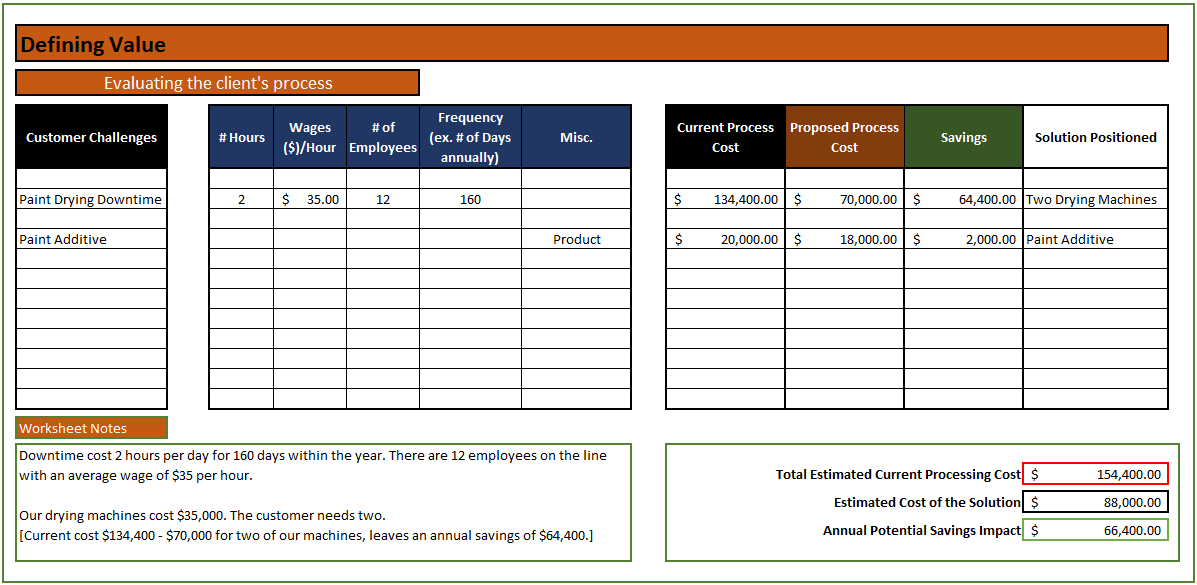
Handling Objections
Objections may be legitimate rejections from the client due to not understanding the full value of the sales team’s value proposition. Objections may also be a tactic used as a negotiation tool to drive down the price. It is important to clarify the situation through a series of questions.
- Ask questions to better understand the objection.
- Restate for clarity.
- Respond with a focus on the value of the proposal, restating the primary elements of the solutions and the overall cost savings or benefits.
- Ensure the responses are appropriate and helpful to the client’s understanding.
- Confirm that the objection is resolved and is not a barrier to moving forward.
As with the discussion during the client visit portion of the text, if an objection continues, defer the meeting with an advance so that the issues can be resolved with more investigative work.
Negotiate terms and conditions
Follow the planned concession process as planned prior to the meeting with the client.
- Anticipate tactics/strategy/dangers.
- Negotiate in good faith for all parties while protecting the profit of the team.
- Make trades that will bring the parties together for a deal.
- Propose a CLOSE and gain agreement to move forward.
Phase 5 Implementation
In the fifth Phase, Implement, finalize the implementation plan, and ensure the full adoption of the solution in the customer’s organization. Align firm’s resources for full support of the sale. Verify negotiated elements are fulfilled.
- Finalize implementation plan.
- Sign agreement (1st Phase in the implementation plan).
- Engage your company resources.
- Customer training.
- Anticipate competitive response.
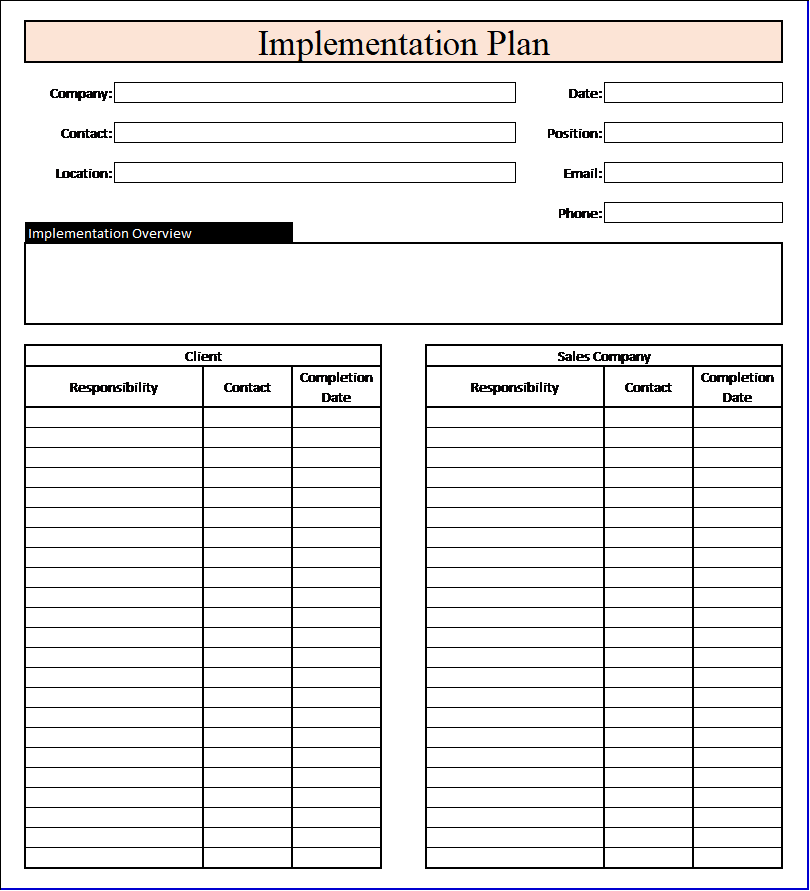
Phase 6 Promote
In the sixth Phase, Promote, confirm new revenue and pursue full adoption of services, expand customer relationships, anticipate changes and new decision makers, communicate ongoing value, and seek the next opportunity.
- Confirm new revenue and pursue full adoption.
- Expand customer relationships.
- Anticipate changes and new decision makers.
- Communicate ongoing value of the agreement and seek next opportunity.
- Quarterly Business Reviews (KDM Level).
Phase 7 Referrals
By the seventh Phase, sales professionals have attained trust and credibility. The team is seen as a true business partner. The client assists in new revenue streams for the firm.
- Referrals to introduce new clients to you and your firm.
- Business Cases for recognition of key players.
Chapter Overview – YouTube channel

